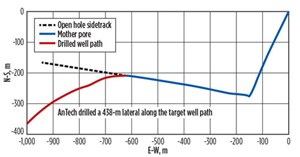Drilling a 6-in. lateral in underbalanced conditions while ensuring effective hole cleaning
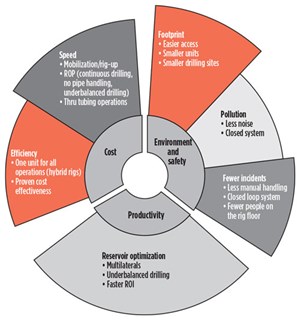
As the oil and gas industry is buffeted by fluctuating oil prices and faces the challenge of diminishing reserves, operators are increasingly in need of an economically viable means of accessing mature and low-yield fields. One solution lies in the technology offered by coiled tubing drilling, which has received a great deal of attention over the last 20 years, due to several distinct benefits that it offers over conventional jointed pipe drilling, Fig. 1.
The most significant of these well-documented benefits is the ability to drill continuously in underbalanced conditions. This protects the integrity of the well formation while increasing the drilling rate, and is particularly useful for sensitive reservoirs. In addition to the benefits associated with managing downhole pressure, CT can also offer faster mobilization speed, reduced rig time and fewer preparation requirements, all of which can lead to significantly reduced operational costs (30%-to-40% reduction in cost, compared with conventional jointed pipe drilling).
CT EVOLUTION
In its infancy, CT was used predominantly for relatively straight-forward operations. But, as the technology has developed, it is increasingly possible to directionally drill larger hole diameters with CT. This has led to the technique being used for more complex, deeper wells, whether to drill entire wells, or to drill multilaterals to several targets by exiting an existing wellbore. As a result, fields previously thought to be inaccessible, because they didn’t make economic sense, can now be exploited. This makes low-margin drilling operations a viable proposition for operators.
Advances in technology open up CT commercialization. As a new generation of engineers and technologists filters through the ranks, different technologies are being developed to unlock the potential of mature wells, and increase operational efficiency. The many well-documented benefits of CT, combined with the continual improvement in technology, and increasing number of successful commercial operations, is resulting in a wider market acceptance, and usage of the technique across a range of applications.
UK-based directional coiled tubing drilling (DCTD) specialist, AnTech, recognized that an economical solution to accessing mature fields lay in the speed and underbalanced capabilities of DCTD. The company has spent many years designing and developing its proprietary DCTD BHAs, COLT (3.2-in. OD) and POLARIS (5-in. OD). Both tools can be used for re-entry applications, and the POLARIS tool is targeted at larger hole sizes up to 8½ in., making it suitable for grass-roots drilling as well.
LUNDIN PETROLEUM’S UB CT DRILLING PROJECT
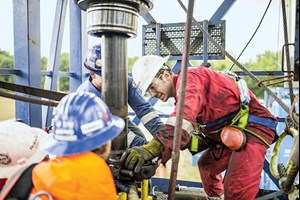
During 2014, AnTech was awarded an Underbalanced Coiled Tubing Drilling (UBCTD) project for Swedish oil and gas company, Lundin Petroleum, operating in Villerperdue oil field within the Paris basin, of France.
The field is mature, and the wells are depleted to a point where they need to be pumped to produce. The main objective was to increase production by drilling a new lateral, from an existing wellbore, to access previously undrained parts of the reservoir. Due to a thin payzone, it was a requirement that the wellbore be kept within tight vertical depth limits, to ensure that the well would be fully contained during drilling, and to minimize the risk of increasing the water cut without producing any extra oil. The drilling fluid selected was a combination of nitrogen and diesel, selected to protect and maintain UB conditions.
Further project objectives required the team to initiate an open-hole sidetrack inside the porous reservoir boundaries, without dropping more than 2 m from the existing wellbore, during the open-hole sidetrack or the target 300-m lateral, while keeping the well underbalanced. The proposed well was already horizontal, with the casing shoe set at just below 70° from vertical. The reservoir section had been drilled previously with a 6 1/8-in. bit and completed open-hole.
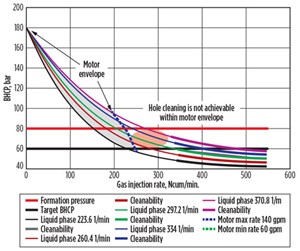
Pre-well modeling. For any CT job to be viable, it is fundamental that the coiled tubing be capable of transferring sufficient weight to the bit, to maintain an effective ROP. In addition, while maintaining a sufficiently energetic flow regime in the annulus to clean the hole, the downhole pressures must be low enough to prevent lost circulation and formation damage; and the internal coiled tubing pressure at surface must be low enough to avoid premature tubing fatigue.
To ensure that these conditions could be met during the Villerperdue operation, and that the work could be completed successfully, considerable pre-well analysis and modeling was carried out. The modelling was completed in-house by AnTech using its proprietary ATLAS software, which was designed specifically for CT modeling. Feasibility modeling focused on three main areas:
- Wellpath planning. This was used to establish a suitable wellpath, using the required lateral distance, based on the data provided by the operator. Factors considered were the motor bend that would be required to generate the required build, and the ability to drill the curve and the horizontal section in one run.
- Weight-on-bit (WOB). Tubing forces modelling was used to demonstrate the achievable WOB at all depths, to ensure that sufficient weight could be transferred to the bit at all stages of the operation.
- Hole cleaning and pressures. Hole cleaning analysis was carried out, to ensure that the wellbore could be cleaned adequately, with the range of possible flowrates and fluid system chosen, while keeping pressures under control to protect the reservoir and enhance the life of the CT.
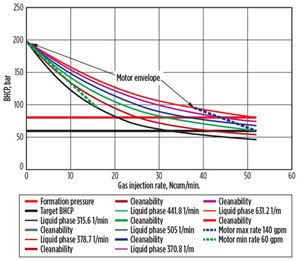
Wellpath planning, using the ATLAS software, showed that the proposed well profile could be achieved with an adjustable kick-off (AKO) setting of 1.15° on the mud motor. However, it indicated that selecting a higher AKO setting of 1.83° could aid with the open-hole sidetrack, depending on the chosen method. This would be at the limit of the bend that would allow the straight section to be drilled in the same run as the build section, something that is only possible with AnTech CT BHAs.
Tubing force modeling indicated that achieving sufficient WOB should not be a problem for the well, with just over 15kN WOB achievable in the reservoir zone. Hydraulic models were run to show the expected pressure at any point within the well, and enable AnTech to determine which of its two BHAs would be suitable for the operation.
Figures 3 and 4 compare achievable bottom hole circulation pressures (BHCP), at a variety of liquid and gas phase flowrates, using AnTech’s 3.2-in.-OD COLT and 5-in.-OD POLARIS BHAs. The lower horizontal line indicates the target BHCP, as specified by the operator, and the thicker lines indicate that correct hole cleaning is possible. Hydraulic modeling demonstrated that it would not be possible to clean the well of cuttings within the motor flow limits for the smaller OD COLT tool, Fig. 3. However, modeling revealed it would be possible to clean the well, and maintain the desired underbalanced conditions, at a range of different fluid and gas phase flowrates with the larger OD POLARIS tool, Fig. 4.
DEPLOYMENT AND RESULTS
As a result of the pre-well modelling, the magnetically steered POLARIS BHA was selected for the operation, making it the first CT BHA of its size to be deployed in Europe. The project was completed in collaboration with two other partners, to provide a complete service package for the operator. The service firm successfully drilled, to target, a 438-m lateral within the required window, at speeds up to five times the rate at which the original lateral was drilled in overbalanced conditions, Fig. 5. The well was kept fully contained, at all times, and there were no HSE incidents during the operation.
The magnetically steered tool configuration, developed by the service provider specifically for this project, enabled uninterrupted fluid circulation, thus avoiding downtime that would otherwise allow stable flow conditions to be re-established after stopping, and then re-commencing, circulation. Owing to the fact that it typically takes a long time to regain equilibrium with multi-phase flow, this reduction in downtime offers significant time and cost savings. Magnetic measurement also eliminated the need to stop pumping to take a survey (which would be required if using the gyro-steered POLARIS tool), therefore providing constant directional survey data.
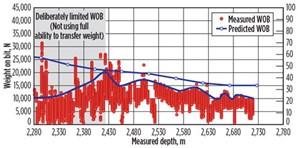
This real-time feedback provided the high level of accuracy required, to reduce the risk of dropping below the narrow target formation, when performing the open-hole sidetrack in the already horizontal wellbore. The results demonstrate that AnTech’s POLARIS tool is suitable for drilling directionally, while maintaining sufficient two-phase flow for effective hole cleaning.
Modeling software validation. Comparing pre-well modelling outputs, and observed drilling conditions, allowed AnTech to validate the accuracy and reliability of its ATLAS software. This comparison confirmed that, at the greater depths where the service firm’s directional drillers were attempting to apply maximum WOB, the measured WOB readings followed the modelled maximum, demonstrating the reliability of ATLAS for tubing forces modelling, Fig. 6. In addition, downhole pressures indicated by hydraulic modeling were achieved with the volumes pumped, resulting in effective hole-cleaning during the operation, Fig. 7.
THE FUTURE OF DCTD APPLICATIONS
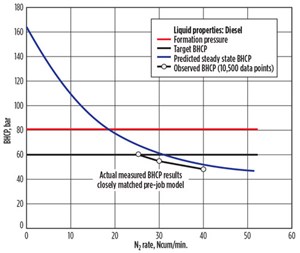
DCTD represents a specialized service within the upstream market, with significant potential for operators. Successful use of DCTD calls for the close collaboration of experts in a number of fields to gain the right combination of drilling, logging, well engineering, testing and software skills. As technology improves, and the environmental benefits are recognized, the range and number of drilling operations looks set to increase. With increased competition among service providers driving the development of CT BHA technology; the reduction of operational costs, and the improvement of service offerings, there can be no doubt that the oil and gas industry will continue to embrace DCTD as a reliable and economically viable technique for unlocking the potential of mature, under-producing oil fields. ![]()

- Coiled tubing drilling’s role in the energy transition (March 2024)
- Digital tool kit enhances real-time decision-making to improve drilling efficiency and performance (February 2024)
- E&P outside the U.S. maintains a disciplined pace (February 2024)
- U.S. operators reduce activity as crude prices plunge (February 2024)
- Drilling advances (January 2024)
- Driving MPD adoption with performance-enhancing technologies (January 2024)

